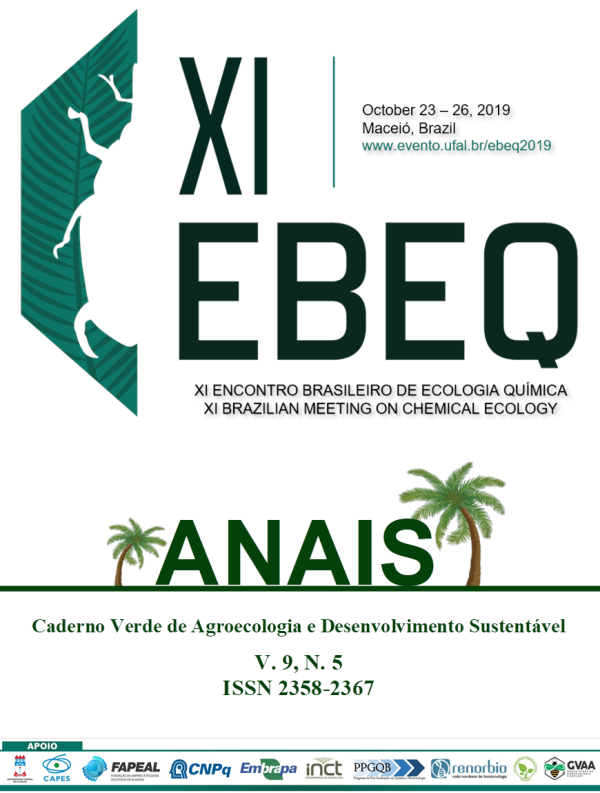IDENTIFICATION OF THE AGGREGATION PHEROMONE OF TWO PALM WEEVILS, Rhinostomus barbirostris AND Amerrhinus ynca (COLEOPTERA: CURCULIONIDAE)
Palabras clave:
Arecaceae, INTEGRATED PEST MANAGEMENT, SEMIOCHEMICALSResumen
Palm trees (Arecaceae) cultivation represents an important source of income for many Brazilian states, highlighting Brazil among the major world producers. In Bahia State, coconut and palm oil crops stand out in economic importance. However, the producers suffer year after year with high economic losses due to insect pest attack, mainly by weevils (Curculionidae), such as the bearded weevil Rhinostomus barbirostris and the rachis borer Amerrhinus ynca. A. ynca is a very important pest of the adult coconut tree, although its attack has also been observed on young plants with formed stem. The larvae attack is characterized by large internal galleries located in the rachis, which lead to the weakening and breakage of the leaves. The R. barbirostris larvae form galleries in the stem which reduce or interrupt the sap flow, causing breakage of the leaves and weakening of the plant. Besides the direct damage, R. barbirostris may be a vector of diseases in coconut and oil palms, such as stem bleeding (resinosis) and red ring disease. In this talk, I will present the identification of the aggregation pheromone produced by R. barbirostris and by A. ynca, the first two works of our research group with insects of the family Curculionidae.Descargas
Publicado
Cómo citar
Número
Sección
Licencia
Termo de cessão de direitos autorias
Esta é uma revista de acesso livre, em que, utiliza o termo de cessão seguindo a lei nº 9.610/1998, que altera, atualiza e consolida a legislação sobre direitos autorais no Brasil.
O(s) autor(es) doravante designado(s) CEDENTE, por meio desta, publica a OBRA no Caderno Verde de Agroecologia e Desenvolvimento Sustentável, representada pelo Grupo Verde de Agroecologia e Abelhas (GVAA), estabelecida na Rua Vicente Alves da Silva, 101, Bairro Petrópolis, Cidade de Pombal, Paraíba, Brasil. Caixa Postal 54 CEP 58840-000 doravante designada CESSIONÁRIA, nas condições descritas a seguir:
O CEDENTE declara que é (são) autor(es) e titular(es) da propriedade dos direitos autorais da OBRA submetida.
O CEDENTE declara que a OBRA não infringe direitos autorais e/ou outros direitos de propriedade de terceiros, que a divulgação de imagens (caso as mesmas existam) foi autorizada e que assume integral responsabilidade moral e/ou patrimonial, pelo seu conteúdo, perante terceiros.
O CEDENTE mantêm os direitos autorais e concedem à revista o direito de divulgação da OBRA, com o trabalho simultaneamente licenciado sob a Licença Creative Commons do tipo atribuição CC-BY.
O CEDENTE têm autorização para distribuição não-exclusiva da versão do trabalho publicada nesta revista.
O CEDENTE têm permissão e são estimulados a publicar e distribuir seu trabalho online (ex.: em repositórios institucionais ou na sua página pessoal) a qualquer ponto antes ou durante o processo editorial, já que isso pode gerar alterações produtivas, bem como aumentar o impacto e a citação do trabalho publicado.








